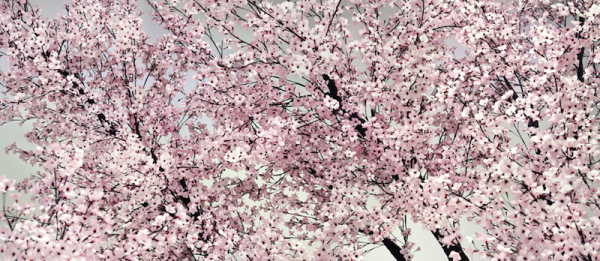Drew Sawyer on Thomas Demand

Thomas Demand, Bloom, 2014. All photographs © Artists Rights Society (ARS), New York / VG Bild-Kunst, Bonn / Courtesy Matthew Marks Gallery
Two exhibitions, at Los Angeles County Museum of Art and Matthew Marks Gallery’s Los Angeles location, feature German-born photographer Thomas Demand, who lives and works in Los Angeles. Demand creates models which he then photographs: At Matthew Marks, he debuts new photographs, while at LACMA he shows a work of stop-motion animation. Drew Sawyer, the Beaumont and Nancy Newhall Curatorial Fellow at the Museum of Modern Art, considers the effect the artist’s new relationship to the West Coast has on this body of images.
Thomas Demand’s current multiple exhibitions in Los Angeles, where the German-born artist has lived since 2010, serve as evidence of a subsequent shift in his practice. Since the early 1990s, Demand has produced photographs of seemingly ordinary places and objects: paper-strewn offices, sterile hallways, and modernist staircases. He typically begins with an existing image of political or cultural relevance culled from archives or the media that he then translates into a three-dimensional paper model. He came to this circuitous and labor-intensive method while attending the Kunstakademie in Düsseldorf, where he trained as a sculptor with Fritz Schwegler. Though he did not study with Bernd and Hilla Becher, he clearly shares their concern for documenting banal-looking places and structures with deep historical significance.

Atelier, 2014
In an exhibition of new works at both of Matthew Marks’s West Hollywood galleries, Demand presents large-scale photographs of paper models based on photographs. Although the form feels familiar, this new series relates to recent events or art and architectural history, whereas his prior show, in New York, in 2013 to 2014, presented pictures made from casual cellphone snaps. The current exhibition includes images charged with more political and cultural commentary: Backyard (2014) is drawn from a New York Times photograph of Boston Marathon bomber Tamerlan Tsarnaev’s home in Cambridge. A thirteen-foot-long photograph, Bloom (2014), focuses on cherry blossoms in the background of the same backyard, further removing the image from its disquieting source material. These photographs are juxtaposed with two images modeled after Matisse’s studio, where added colorful paper scraps on the herringbone floor reference the modernist master’s late cutouts—playfully referencing Demand’s own paper constructions. Demand’s exclusion of human figures—he removed Tsarnaev’s wife from the source photograph in Backyard as well as a wheelchair-bound Matisse in Atelier (2014)—recalls forensic photography, a genre of images from which he often draws. As with his previous photographs, both bodies of work reflect on the circulation of images and the loss of context in the construction of historical memory.

Sidegate, 2014
Other photographs on view push his practice in new conceptual directions. He reimagines the Santa Monica balcony belonging to mob boss and fugitive Whitey Bulger and a gated entrance to the Southern California home of Nakoula Basseley Nakoula, the writer and producer behind the 2012 anti-Islamic video Muslim Innocence. While drawn from the news, these works are not based on existing images. Rather, Demand’s proximity to the locations allowed him to carry out his own espionage, and the images allegorize the themes of privacy and transparency by focusing on visual barriers: a large solid gate or a barred balcony in front of sliding glass doors with drawn curtains. Without preexisting images, we are offered even less access to these places, and even Demand’s own experience of them does not offer much information.
At Matthew Marks’s second space, Demand shows new photographs of architectural models by the Tokyo-based architectural firm SANAA. These images continue his series of models of unrealized structures by the mid-century Californian architect John Lauder, which Demand carried out while a visiting scholar at the Getty Research Institute in 2010. The photographs represent the first time the artist has photographed models he did not build, and push his exploration of representation and abstraction even further.

Pacific Sun, 2012, production still
Demand’s recent film Pacific Sun, a one-hundred-second stop-motion animation based on security footage from a cruise ship dining room during a tumultuous storm off the coast of New Zealand, is also currently on view, at the Los Angeles County Museum of Art. Demand also began the film at the Getty Research Institute, where he and a team of assistants meticulously recreated, in 2,400 photographs of paper models, the violent movement of hundreds of objects from one side of the cafeteria to the other. The result is one of Demand’s most ambitious works to date. His first film Tunnel, from 1999, was a track shot of a thirty-two-meter-long cardboard model of an underpass that evokes the 1997 death of Princess Diana of Wales by car crash. Both films, like his photographs related to the Boston Marathon bomber and the fugitive mob boss, explore our contemporary moment of insecurity and surveillance via the media. In a culture with an excess of images that serve as either means of power or distraction, how does one wrest control of their incessant flow? Demand’s recent photographs and films may not provide the answers, but they are asking the right questions.
Pacific Sun at LACMA runs through April 12.
Thomas Demand at Matthew Marks runs through April 4.























